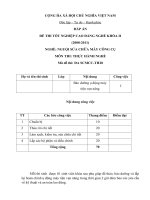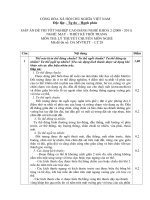PASSAGE 28
Bạn đang xem bản rút gọn của tài liệu. Xem và tải ngay bản đầy đủ của tài liệu tại đây (50.32 KB, 3 trang )
PASSAGE 28
The world is not a happy place — at least, not according to the people living in it. This week, analytics
firm Gallup shared the results of a global survey designed to gauge the world’s emotional temperature.
Their report suggests that people are sadder, angrier, and more worried than ever before recorded —
findings that could have profound implications for global health.
For its 2018 Global State of Emotions report, Gallup conducted more than 151,000 interviews with
adults living in more than 140 countries. They asked survey respondents questions about how they felt the
day prior, such as whether they smiled or laughed a lot, and whether they felt sadness or anger. They
found that the number of people who said they’d experienced anger increased by two percentage points
over the previous year, while both worry and sadness increased by one percentage point — setting new
record highs for all three negative emotions.
Research has noted the impact negative feelings can have on a person’s physical health — studies have
linked anger to an elevated risk of heart attack and stroke, while chronic worry and sadness can be signs
of anxiety disorders and depression, which carry an increased risk of heart disease. If people continue to
experience these negative emotions in greater numbers, we could be headed toward a future in which the
global population is increasingly unhealthy — a situation that carries its own troubling side effects.
(Adapted from )
Question 1. Which of the following can be the title of the passage?
A. How To Be Happier, According to New Study
B. We Are Living In A Sadder and Angrier World
C. The Increase In Heart Disease Due To Sadness
D. Why People Are More Stressed Nowadays
Question 2. What would likely happen in the future if more and more people experienced negative
feelings?
A. people would be more anxious and depressed.
B. many people would die from heart attacks and strokes.
C. the health of people around the world would worsen.
D. the global population can have troubling side effects on the world.
Question 3. The word “gauge” in paragraph 1 can be best replaced by __________.
A. assess
B. confirm
C. approve
D. support
Question 4. The word “They” in paragraph 2 refers to ___________.
A. questions
B. respondents
C. Gallup
D. adults
Question 5. All of the following are mentioned in the passage as harmful effects on people’s health linked
to negative emotions EXCEPT ___________.
A. Heart attack
B. Depression
C. Stroke
D. Chronic worry
Page 1
ĐÁP ÁN
1-B
2-C
3-A
4-C
5-D
LỜI GIẢI CHI TIẾT
Question 1:
Điều nào sau đây có thể là tiêu đề của đoạn văn?
A. Làm thế nào để hạnh phúc hơn, theo nghiên cứu mới
B. Chúng ta đang sống trong một thế giới buồn và giận dữ hơn
C. Sự gia tăng bệnh tim do buồn bã
D. Tại sao ngày nay mọi người càng căng thẳng
Dẫn chứng:
Đoạn 1: Their report suggests that people are sadder, angrier, and more worried than ever before recorded
— findings that could have profound implications for global health.(Báo cáo của họ cho thấy mọi người
buồn hơn, giận dữ hơn và lo lắng hơn bao giờ hết được ghi nhận - những phát hiện có thể có ý nghĩa sâu
sắc đối với sức khỏe tồn cầu.)
Đoạn 2: they found that the number of people who said they’d experienced anger increased by two
percentage points over the previous year, while both worry and sadness increased by one percentage point
— setting new record highs for all three negative emotions.( họ thấy rằng số người nói rằng họ đã trải qua
sự tức giận tăng hai điểm phần trăm so với năm trước, trong khi cả lo lắng và buồn bã đều tăng thêm một
điểm phần trăm - thiết lập mức cao kỷ lục mới cho cả ba cảm xúc tiêu cực.)
Đoạn 3: ảnh hưởng của cảm xúc tiêu cực với thể chất của con người.
Question 2:
Điều gì có thể xảy ra trong tương lai nếu ngày càng nhiều người trải qua cảm giác tiêu cực?
A. mọi người sẽ lo lắng và chán nản hơn.
B. nhiều người sẽ chết vì đau tim và đột quỵ.
C. sức khỏe của mọi người trên khắp thế giới sẽ xấu đi.
D. dân số toàn cầu có thể có tác dụng phụ đáng lo ngại trên thế giới.
Dẫn chứng: If people continue to experience these negative emotions in greater numbers, we could be
headed toward a future in which the global population is increasingly unhealthy — a situation that carries
its own troubling side effects.
Dịch: Nếu mọi người tiếp tục trải qua những cảm xúc tiêu cực này với số lượng lớn hơn, chúng ta có thể
hướng đến một tương lai trong đó dân số tồn cầu ngày càng khơng lành mạnh - một tình huống mang lại
những tác dụng phụ đáng lo ngại.
Question 3:
Từ “ Gauge” trong đoạn 1 có thể được thay thế phù hợp nhất bơi…
A. Đánh giá
B. Xác nhận
C. Chứng minh
D. Hỗ trợ
Dẫn chứng: This week, analytics firm Gallup shared the results of a global survey designed to gauge the
world’s emotional temperature.
Dịch: Tuần này, cơng ty phân tích Gallup đã chia sẻ kết quả của một cuộc khảo sát toàn cầu được thiết kế
để đánh giá nhiệt độ cảm xúc của thế giới.
Page 2
Question 4:
Từ “they” trong đoạn 2 đề cập đến?
A. Những câu hỏi
B. Người trả lời
C. Gallup ( Viện thăm dò ý kiến dư luận)
D. Người lớn
Dẫn chứng: For its 2018 Global State of Emotions report, Gallup conducted more than 151,000
interviews with adults living in more than 140 countries. They asked survey respondents questions about
how they felt the day prior, such as whether they smiled or laughed a lot, and whether they felt sadness or
anger. They found that the number of people who said they’d experienced anger increased by two
percentage points over the previous year, while both worry and sadness increased by one percentage point
— setting new record highs for all three negative emotions.
Dịch: Đối với báo cáo Trạng thái cảm xúc toàn cầu năm 2018, Gallup đã thực hiện hơn 151.000 cuộc
phỏng vấn với người lớn sống ở hơn 140 quốc gia. Họ đã hỏi những người trả lời khảo sát về câu hỏi họ
cảm thấy như thế nào vào ngày hôm trước, chẳng hạn như họ cười hay cười nhiều, và liệu họ có cảm thấy
buồn hay tức giận. Họ(gallup) phát hiện ra rằng số người nói rằng họ đã trải qua sự tức giận tăng hai điểm
phần trăm so với năm trước, trong khi cả lo lắng và buồn bã tăng thêm một điểm phần trăm - thiết lập
mức cao kỷ lục mới cho cả ba cảm xúc tiêu cực.
Question 5:
Tất cả những điều sau đây được đề cập trong đoạn văn là những tác động có hại đối với con người Sức
khỏe liên quan đến những cảm xúc tiêu cực NGOẠI TRỪ ___________.
A. Đau tim
B. Trầm cảm
C. Đột quỵ
D. Lo lắng kinh niên
Dẫn chứng: Research has noted the impact negative feelings can have on a person’s physical health —
studies have linked anger to an elevated risk of heart attack and stroke, while chronic worry and sadness
can be signs of anxiety disorders and depression, which carry an increased risk of heart disease.
Dịch: Nghiên cứu đã ghi nhận những tác động tiêu cực mà cảm giác tiêu cực có thể gây ra đối với sức
khỏe thể chất của một người - các nghiên cứu đã liên kết sự tức giận với nguy cơ đau tim và đột quỵ tăng
cao, trong khi lo lắng và buồn bã mãn tính có thể là dấu hiệu của rối loạn lo âu và trầm cảm, làm tăng
nguy cơ mắc bệnh tim dịch bệnh.( tức là lo lắng kinh niên là 1 loại cảm xúc tiêu cực dẫn đến ảnh hưởng
tiêu cực đến sức khỏe, nó khơng phải là căn bệnh)
Page 3









